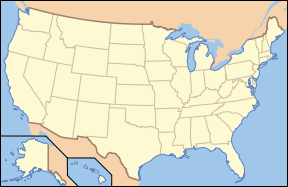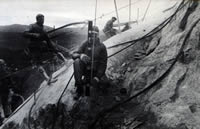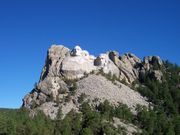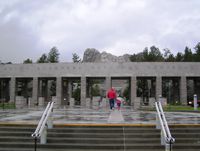Mount Rushmore
2007 Schools Wikipedia Selection. Related subjects: North American Geography
| Mount Rushmore National Memorial | |
|---|---|
| IUCN Category V (Protected Landscape/Seascape) | |
| Location: | South Dakota, USA |
| Nearest city: | Keystone, SD |
| Coordinates: | |
| Area: | 1,278.45 acres (5.17 km²) |
| Established: | March 3, 1925 |
| Visitation: | 2,031,517 (in 2004) |
| Governing body: | National Park Service |
Mount Rushmore National Memorial, near Keystone, South Dakota, is a United States Presidential Memorial that represents the first 150 years of the history of the United States of America with the 60-foot (18 m) sculptures of former U.S. Presidents George Washington, Thomas Jefferson, Theodore Roosevelt, and Abraham Lincoln. The entire memorial covers 1,278 acres (5.17 km²), and is 5,725 feet (1,745 m) above sea level. It is managed by the National Park Service, a bureau of the United States Department of the Interior. The memorial attracts around 2 million people annually.
The mountain known to the Lakota Sioux as Six Grandfathers was renamed after Charles E. Rushmore, a prominent New York lawyer, in 1885. The project of carving Mount Rushmore originally started with the purpose of increasing tourism in the Black Hills region of South Dakota. After long negotiations involving a Congressional delegation and President Calvin Coolidge, the project received Congressional approval. The carving started in 1927 and ended in 1941, and although there were a few injuries, no deaths occurred.
History
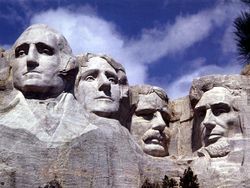
The geological formation of Mount Rushmore was known to the Lakota as Six Grandfathers and was part of the route that Lakota leader Black Elk took in a well-known spiritual journey that culminated at Harney Peak. Following a series of military campaigns in 1876-77, the United States asserted territorial control over the area, a claim that is still disputed on the basis of the 1868 Treaty of Fort Laramie (see Controversy below). Among white American settlers, the peak was known variously as Cougar Mountain, Sugarloaf Mountain, Slaughterhouse Mountain, and Keystone Cliffs. It was named Mount Rushmore during a prospecting expedition by Rushmore, David Swanzey and Bill Challis.
Doane Robinson, a historian, conceived the idea for Mount Rushmore in 1923 in order to attract greater tourism to South Dakota. In 1924, Robinson persuaded sculptor Gutzon Borglum to go to the Black Hills region to ensure that the carving could be accomplished. Borglum, a member of the Ku Klux Klan, was then involved in sculpting a massive bas-relief memorial to Confederate leaders on Stone Mountain in Georgia. The original plan was to do the carvings in the Needles, several granite pillars. However, Borglum realized that that plan could not be carried out because the Needles, worn down by erosion, were too thin to support sculpting. He chose Mount Rushmore, a grander spot, partly because it faced southeast and enjoyed maximum exposure to the sun. Borglum said upon seeing Mount Rushmore, "America will march along that skyline." Congress authorized the Mount Rushmore National Memorial Commission on March 3, 1925. President Coolidge insisted that along with Washington, two Republicans and one Democrat be portrayed.
Between October 4, 1927 and October 31, 1941, Gutzon Borglum and 400 workers sculpted the 60 foot (18 m) colossal carvings of Presidents George Washington, Thomas Jefferson, Theodore Roosevelt, and Abraham Lincoln to represent the first 150 years of American history. These presidents were selected by Borglum because of their role in preserving the Republic and expanding its territory.
In 1933, the National Park Service took Mount Rushmore under its jurisdiction. Engineer Julian Spotts helped with the project by improving its infrastructure. For example, he had the tram upgraded such that it could reach the top of Mount Rushmore for the ease of workers. By July 4, 1934, Washington's face had been completed and was dedicated. The face of Thomas Jefferson was dedicated in 1936, and the face of Abraham Lincoln was dedicated on September 17, 1937. In 1937, a bill was introduced in Congress to add the head of civil rights leader Susan B. Anthony, but a rider was passed on an appropriations bill requiring that federal funds be used to finish only those heads that had already been started at that time. In 1939, the face of Theodore Roosevelt was dedicated.
The Sculptor's Studio was built in 1939 under the direction of Gutzon Borglum. Unique plaster models and tools related to the sculpting process are displayed there. Borglum died from an embolism in March of 1941. His son, Lincoln Borglum, continued the project, but insufficient funding forced the carving to end. Originally, it was planned that the sculpture would be carved from head to waist. Borglum also planned a massive panel in the shape of the Louisiana Purchase commemorating in eight-foot-high gilded letters the Declaration of Independence, U.S. Constitution, Louisiana Purchase, and seven other territorial acquisitions from Alaska to Texas to the Panama Canal Zone.
The entire project had cost $989,992.32. Notably for a project of such size, no workers died during the carving.
On October 15, 1966, Mount Rushmore was listed on the National Register of Historic Places. An essay from Nebraska student William Andrew Burkett was placed on the Entablature on a bronze plate in 1973. It had been selected as the winner for the college-age group in 1934. In 1991, President George Bush officially dedicated Mount Rushmore.
Ten years of redevelopment work culminated with the completion of extensive visitor facilities and sidewalks in 1998. These include a Visitor Centre, Museum, and the Presidential Trail. Maintenance of the memorial presents a unique challenge for conservators, often requiring mountain climbing to remove lichens and generally clean the memorial. On July 8, 2005, Kärcher GmbH, a German manufacturer of cleaning machines, conducted a cleanup operation of the faces by pressure washing for free. The washing used pressurized water that was 200 degrees Fahrenheit (93 degrees Celsius).
Controversy
Mount Rushmore is controversial among Native Americans because the United States seized the area from the Lakota tribe after the Black Hills War in 1876–77. The Treaty of Fort Laramie (1868) had previously granted the Black Hills to the Lakota in perpetuity. The Lakota consider the hills to be sacred, although historians believe the Lakota also gained control of the hills by force, displacing the Cheyenne in 1776. Members of the American Indian Movement led an occupation of the monument in 1971, naming it "Mount Crazy Horse." Among the participants were young activists, grandparents, children and Lakota holy man John Fire Lame Deer, who planted a prayer staff atop the mountain. Lame Deer said the staff formed a symbolic shroud over the presidents faces "which shall remain dirty until the treaties concerning the Black Hills are fulfilled."
The Monument continues to be a subject of controversy among Native Americans, even after the appointment of Gerard Baker, the first Native American superintendent of the park in 2004. The Crazy Horse Memorial is being built elsewhere in the Black Hills to commemorate a famous Native American leader and as a response to Mount Rushmore. It is intended to be larger than Mount Rushmore and has the support of Lakota chiefs, though the monument is not being financed with federal funds for the most part.
Ecology
The flora and fauna of Mount Rushmore are similar to those of the rest of the Black Hills region of South Dakota. The memorial serves as home to many animals and plants representative of the Black Hills. Several birds like the turkey vulture, bald eagle, hawk, and meadowlark fly around Mount Rushmore, occasionally making nesting spots in the ledges of the mountain. Smaller birds, including songbirds, nuthatches, and woodpeckers, inhabit the surrounding pine forests. Terrestrial mammals include the mouse, chipmunk, squirrel, skunk, porcupine, raccoon, beaver, badger, coyote, bighorn sheep and bobcat. In addition, several species of frogs and snakes inhabit the region. The two brooks in the memorial, the Grizzly Bear and Starling Basin brooks, support fish like the longnose dace and the brook trout. Some endemic animals are not indigenous to the area; the mountain goats are descended from goats which were a gift from Canada to Custer State Park in 1924 but later escaped.
At lower elevations, coniferous trees, mainly the Ponderosa pine, surround most of the monument, providing much shade from the sun. Other trees include the bur oak, the Black Hills spruce, and the cottonwood. Nine species of shrubs live near Mount Rushmore. There is also a wide variety of wildflowers, including especially the snapdragon, sunflower, and violet. Towards higher elevations, plant life becomes sparser. However, only approximately 5% of the plant species found in the Black Hills are indigenous to the region.
Though the area receives about 18 inches (460 mm) of precipitation on average per year, alone it is not enough to support the abundant animal and plant life. Trees and other plants help to control surface runoff. Dikes, seeps, and springs help to dam up water that is flowing downhill, providing watering spots for animals. In addition, stones like sandstone and [limestone] help to hold groundwater, creating aquifers.
Forest fires occur in the Ponderosa forests surrounding Mount Rushmore around every 27 years. This was determined from fire scars in tree core samples. These help to clean forest debris located on the ground. Large conflagrations are rare, but have occurred in the past.
Geology
Mount Rushmore is largely composed of granite. The memorial is carved on the northwest margin of the Harney Peak granite batholith in the Black Hills of South Dakota, so the geologic formations of the heart of the Black Hills region are also evident at Mount Rushmore. The batholith magma intruded into the pre-existing mica schist rocks during the Precambrian period about 1.6 billion years ago. However, the uneven cooling of the molten rock caused the formation of both fine and coarse-grained minerals, including quartz, feldspar, muscovite, and biotite. Fractures in the granite were sealed by pegmatite dikes. The light colored streaks in the presidents' foreheads are due to these dikes.
The Black Hills granites were exposed to erosion during the late Precambrian, but were buried by sandstones and other sediments during the Cambrian Period. The area remained buried throughout the Paleozoic Era, but was exposed again to erosion during the tectonic uplift about 70 million years ago. The Black Hills area was uplifted as an elongated geologic dome which towered some 20,000 feet (6 km) above sea level, but erosion wore the area down to only 4,000 ft (1.2 km). The subsequent natural erosion of this mountain range allowed the carvings by stripping the granite of the overlying sediments and the softer adjacent schists. The contact between the granite and darker schist is viewable just below the sculpture of Washington.
Borglum selected Mount Rushmore as the site of carving for several reasons. The rock of the mountain was composed of smooth, fine-grained granite. The granite was very resistant, eroding only 1 inch (2.5 cm) every 10,000 years, indicating that it was sturdy enough to support sculpting. In addition, it was the tallest mountain in the surrounding terrain, looming to a height of 5,725 feet (1,745 m) above sea level. Because the mountain faces the southeast, the workers also had the advantage of having the sunlight for most of the day.
Tourism
Tourism is South Dakota's second-largest industry. Mount Rushmore is the number one tourist attraction of South Dakota. In 2004, over 2 million visitors traveled to the memorial.
The Lincoln Borglum Museum is located in the memorial. It features two 125-seat theaters that show a 13-minute movie about Mount Rushmore. One of the best viewpoints is located at Grandview Terrace, above the Lincoln Borglum Museum. The Presidential Trail, a walking trail and boardwalk, starts at Grandview Terrace and winds through the Ponderosa pine forests to the Sculptor's Studio, providing close-up views of the memorial. The Sculptor's studio was built by Gutzon Borglum, and features discussion about the construction of the monument as well as the tools used. The amphitheater also has a 30-minute program at dusk that describes the construction of the memorial. Following that, the mountain is illuminated for two hours.
Appearances in popular culture
Because Mount Rushmore has large carved faces, appearances of Mount Rushmore in the media often include a replacement of one or more of the four presidents' faces with other people or characters. In Naruto, there is a mountain in Konoha with the faces of the Hokages on them. In Superman II, General Zod and his criminal partners use their superpowers to replace three of the carvings with their own faces and wipe out the fourth. Similarly, in Mars Attacks!, the Martians in a UFO carve their faces into Mount Rushmore, replacing the Presidents' heads. Deep Purple's album, In Rock, has the cover inspired by Mount Rushmore: it depicts the five members' faces instead of the four presidents. The Chipmunks' album, Chipmunk Rock, has the cover inspired by Mount Rushmore: it depicts the faces of James Young of Styx, Joey Ramone, Alvin Chipmunk and Frank Zappa instead of the four presidents. In the Red Dwarf novel Better Than Life, Dave Lister finds Mount Rushmore half-buried underneath garbage, which causes him to realize he is back on Earth. The mountain has had a fifth face carved into it, that of fictional president Elaine Salinger.
Because the mountain is an important historical landmark, it is often used as a base for various action-themed movies and books. Mount Rushmore is featured in Team America: World Police as the Team America headquarters, where it was destroyed by Michael Moore's suicide bomb. In Wildstorm Comics, the alien superhero Mr. Majestic has his secret base inside Mount Rushmore. In DC Universe, the All Purpose Enforcement Squad has its secret base in Mount Rushmore.
The memorial was famously used as the location of the final chase scene in Alfred Hitchcock's movie North by Northwest. However, it was not actually filmed at the monument, since permission to shoot an attempted killing on the face of a national monument was refused by the Park Service. Closeups were shot on a set. In the Family Guy episode " North by North Quahog", Peter and Lois are chased down the monument by Mel Gibson after stealing a copy of his new movie, "Passion Of The Christ 2: Crucify This" in a spoof of the chase scene from North by Northwest. Peter refers to one of the faces as "President Rushmore".
In The Simpsons episode #8F01 (" Mr. Lisa Goes to Washington"), during a shady meeting with a Congressman, a wealthy lobbyist states: "We want to drill for oil in Teddy Roosevelt's head." The Congressman is initially reluctant, but after the lobbyist opens a suitcase full of money the Congressman immediately replies: "Teddy who?"
In the television movie 10.5: Apocalypse, Mount Rushmore is destroyed by an earthquake In Category 7: The End of the World, the head of George Washington is cut off from the mountain by weather problems.
In the movie of Richie Rich The Rich family vault is held inside "Mount Richmore", a large mountain with the three family members' faces carved into the side.
In the computer adventure game Sam & Max Hit the Road, the characters Sam & Max visit Mt. Rushmore after reading brochures given to them by Evelyn Morrison at Jungle Fever.
Mt.Rushmore is one of the national wonders buildable in the run-the-state strategy computer game Civilization IV. This wonder is available after the discovery of Fascism and the main ingame effect is to reduce war weariness.
